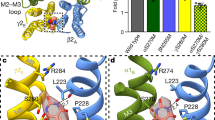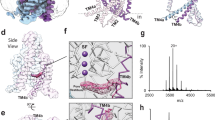Abstract
IT is generally accepted that neutral anaesthetics, such as the n-alkanols and n-alkanes, act from a hydrophobic site1. Discussion has tended to focus on the nature of this site and, particularly, whether it is located in a membrane protein or in the interior of a bilayer2,3. If the site is in a bilayer then the question arises as to how the proteins involved in nervous impulse propagation are affected. We present here new evidence concerning the anaesthetic properties of the n-alkanes which points to the bilayer as the site of action and also suggests a mechanism for the inhibition of impulse propagation. Briefly, the cut-off in anaesthetic potency on ascending the homologous series is found to be closely related to the decrease in adsorption of the alkane into a cholesterol-containing bilayer. In addition, the anaesthetic hydrocarbons produce a concentration-dependent increase in bilayer thickness. On the basis of these two observations, and from our knowledge of the properties of the ion channel-forming polypeptide gramicidin A (ref. 4) we propose that a thickening of the bilayer regions of the nerve membrane by the alkanes destabilises the open ionic channels formed during electrical excitation.
This is a preview of subscription content, access via your institution
Access options
Subscribe to this journal
Receive 51 print issues and online access
$199.00 per year
only $3.90 per issue
Buy this article
- Purchase on Springer Link
- Instant access to full article PDF
Prices may be subject to local taxes which are calculated during checkout
Similar content being viewed by others
References
Seeman, P. Pharmac. Rev. 24, 583–655 (1972).
Boggs, J. M., Yoong, T. & Hsia, J. C. Molec. Pharmac. 12, 127–135 (1976).
Lee, A. G. Nature 262, 545–548 (1976).
Haydon, D. A. & Hladky, S. B. Q. Rev. Biophys. 5, 187–282 (1972).
Fettiplace, R. et al. in Meth. membr. Biol. 4 (ed. Korn, E. D.) 1–75 (Plenum, New York, 1975).
Mullins, L. J. in Handbook of Neurochemistry 6 (ed. Lajtha, A.) 395–421 (Plenum, New York, 1971).
Fühner, H. Biochem. Z. 115, 235–261 (1921).
Ferguson, J. Proc. R. Soc. B 127, 387–404 (1939).
Fettiplace, R., Andrews, D. M. & Haydon, D. A. J. membr. Biol. 5, 277–296 (1971).
Chacko, G. K., Villegas, G. M., Barnola, F. V., Villegas, R. & Goldman, D. E. Biochim. biophys. Acta 443, 19–32 (1976).
Andrews, D. M., Manev, E. D. & Haydon, D. A. Spec. Disc. Faraday Soc. 1, 46–56 (1970).
Rang, H. P. Q. Rev. Biophys. 7, 283–399 (1975).
Almers, W. & Levinson, S. R. J. Physiol., Lond. 247, 483–509 (1975).
Conti, F., DeFelice, L. J. & Wanke, E. J. Physiol., Lond. 248, 45–82 (1975).
Haydon, D. A. Ann. N.Y. Acad. Sci. 268, 2–16 (1975).
Requena, J. & Haydon, D. A. Proc. R. Soc. A 347, 161–177 (1975).
Brink, F. & Posternak, J. M. J. cell. comp. Physiol. 32, 211–233 (1948).
Mautner, H. G. & Clemson, H. C. in Medicinal Chemistry, 3rd edn (ed. Burger, A.) 1365–1383 (Wiley-Interscience, New York, 1970).
Miller, K. W., Paton, W. D. M., Smith, R. A. & Smith, E. B. Molec. Pharmacol. 9, 131–143 (1973).
Author information
Authors and Affiliations
Rights and permissions
About this article
Cite this article
HAYDON, D., HENDRY, B., LEVINSON, S. et al. The molecular mechanisms of anaesthesia. Nature 268, 356–358 (1977). https://doi.org/10.1038/268356a0
Received:
Accepted:
Issue Date:
DOI: https://doi.org/10.1038/268356a0
This article is cited by
-
Characterisation of a synthetic Archeal membrane reveals a possible new adaptation route to extreme conditions
Communications Biology (2021)
-
A pressure-reversible cellular mechanism of general anesthetics capable of altering a possible mechanism for consciousness
SpringerPlus (2015)
-
Direct interaction of a CFTR potentiator and a CFTR corrector with phospholipid bilayers
European Biophysics Journal (2014)
-
Inhibition of protein kinase C by alcohols and anaesthetics
Nature (1993)
-
In memory of Denis Arthur Haydon
The Journal of Membrane Biology (1989)
Comments
By submitting a comment you agree to abide by our Terms and Community Guidelines. If you find something abusive or that does not comply with our terms or guidelines please flag it as inappropriate.



